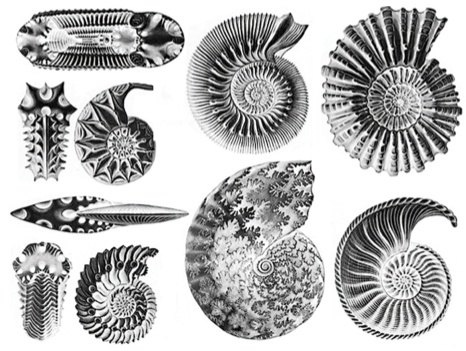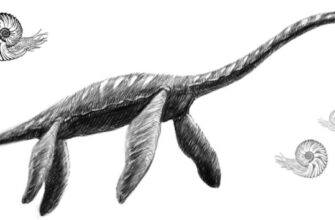Disclaimer: this chapter is translated by DeepL and edited by non-native speaker. The text will be updated after the translation has been corrected by a professional editor.

All the most noble people of human history, while forming their view point on life, came through the stage of mastering sacred paleontology. Don’t mix it up with common paleontology. And it even happened when the mere word “paleontology” didn’t exist. The word “paleontology” appeared relatively recently, in 1822, and it is composed of three Greek words: pale — ancient, ontos — being, logos — studying. The science about extinct and ancient organisms. But this is common paleontology. But not sacred paleontology.
As it has already been said, paleontological objects attracted attention already in the old days — including philosophers’ attention too. The most ancient mentioning of paleontological objects known to us can be found in philosopher Xenophanes (5 century BC). Only hints point out to high antiquity of thinkers’ interest. In particular, the name of such paleontological object as ammonites are mainly linked to the main Ancient Egyptian god Amon. Say, ammonites are named after Amon. But we are aware of people’s passion to explain everything what is going on exactly in the opposite way, this is why the philosopher is obliged to propose and consider an opposite version: and can it be that god Amon is named after ammonites? If such a supposition is true, then it will help to explain things that were left unexplained previously.
Let’s look back to the best of emperors of the Roman Empire — Octavian Augustus. Among other things, it is known that his palace was full of paleontological objects. It can be assumed, of course, that Octavian Augustus, we underline here — the best of Roman Emperors, was simply fond of living in the paleontological museum. But such a strange decoration of his house can also be explained by the fact that he preferred to turn his house — and to do it implicitly — into Amon’s temple, and in this way to link himself closer to the ancient wisdom of sacrificers. If it is true, then it would explain why particularly Octavian Augustus was the most successful of rulers, and the country and the people prospered under his rule.

Unfortunately, the topic of correlation between people’s success and paleontology, to be more exact, with Sacred Paleontology didn’t find its researchers in the new era. And only now, philosopher Alexey Menyailov together with fellowship mates have taken up this subject at last. To start with, he has found out that another extremely successful ruler, and according to many, in fact the most successful ruler in the history of Rus’ (ancient name of Russia), comrade Stalin also started his Path with paleontology, or rather with Sacred Paleontology.
But the list of names discovered by Menyailov is not limited to Stalin. It includes as well the Heroes of the Soviet Union Zoya Kosmodemianskaya, Sasha Chekalin, Sergey Tyulenin, Lyubov Shevtsova and others — in brief, the paramount heroes according to the Commander-in-Сhief. It is particularly noticeable on heroes, that they differed from common people by their exceptionally calm attitude to death. And this calm attitude is one of the benefits of Sacred Paleontology, if you want, the science of Amon.
It is clear that the content of Amon’s science doesn’t coincide with the content of common paleontology, at least because common paleontologists are not distinguished by heroism of mind — if not the opposite.
Thus it means, all these stratigraphies and classifications of common paleontologists are not relevant for the higher knowledge. But what is the object of study then, if not the books on extinct animals? The target object of study, same as the tool of initiation to the basic levels of Amon’s sacrificers, should be rather accessible.
And in fact, let’s consider a geological cross-section of sedimentary rocks of Moscow and Moscow region. In the bottom there are light sandstones with ammonites and remains of other organisms, higher there are black clays with diverse fauna, still higher there are clays without fauna and sands, and on the surface we have covering formations (moraines, deluvial clay loams and etc). For that matter, in other places there can be a number of layers of interest, as ammonites lived in the Devonian, in the Carboniferous, in the Permian, in the Triassic and in the Jurassic, and finally in the Crataceous until they entirely disappeared on the edge of the Cretaceous and the Paleocene, put simply, until they die out once and for all.
So it is enough to take along a shovel, a chisel and a hammer to read the entire history of ammonites on a well-chosen cliff of the river with the aim to get clarification in the topic of death, a mystery topic for many people. Of course it is better not to be alone, but with a group or researchers, but real researchers, who are called fellowship mates, in order to join collective mind and to let a better comprehension come or merely to have one.
Ammonites change considerably from layer to layer, in order not to take the same shape in all the following layers, in other words, in superjacent layers.

In common paleontology this characteristic of ammonites is used to identify a discovered layer: what period the layer, containing this kind of ammonites, belongs to. And finally their disappearance once and for all. But some other species continue living and even have lived up to our days.
Here naturally a thought of two types of death appears. First, one can die millions of years ago, but still live in their descendants, their own, their people or in the descendants of their race or species. And second, one can live, gorge, sleep and propagate, but in the meantime, you are already dead for the eternity, because in a few generations you will disappear once and for all. Say, like ammonites on the edge of the Cretaceous and the Paleocene.
What death out of the two is preferable? What death would you prefer to die? The entire life and even every detail of life depends on the choice of death ideal. Since we have looked back to the heroes of the Great Patriotic War Zoya Kosmodemianskaya and Sasha Chekalin, then they, knowing that their chosen death ideal would lead to the situation when fascists would hang them here and now, non the less they calmly went to their death with the name of paleontologist comrade Stalin on their lips. Yes, this is historical truth. Just the same as the one, that cowards and peculators die with whatsoever name on the lips, but not with the one of paleontologist comrade Stalin.
In sacred paleontology there is a number of valuable topics, even highly valuable, and the question of death is probably the smallest one. It is clear that there are more people who loath the Truth, than there are heroes, and heroes should arouse hatred, though concealed because of cowardice, but in certain historical periods rather vividly manifested. For example, paleontologist Zoya Kosmodemianskaya: when fascists were dragging her to hang, Russian speaking inhabitants of the village of Petrischevo were slinging mud at her and were beating, for instance, her legs with an iron rod. These were not individual inhabitants of Petrischevo, as this is how villages function: individual inhabitants wouldn’t have the heart to do anything hostile, if they didn’t feel approval of the whole village, and, the crucial thing, of the ringleaders of all the inhabitants.

Well, all right, they contrived to explain hatred to Zoya with the fact that she burnt the houses, where people who hated Zoya lived. And hatred to Stalin they also contrived to explain by the fact that he allegedly shot up billions of people, and even hundred times more, that is hundreds of billions of people he put to prison; and even though the entire population of the USSR didn’t exceed 190 millions of people, that is to say, even a magician would fail to imprison hundreds of billions of people. But why is Alexander Matrosov hated? When he was 19, he shielded a fire slit with his chest and stopped the fire of the hostile machine gun, saving his fellowship mates. And at the place of the heroic deed near now deserted village of Chernushki, in a wasteland, there is a monument to Alexander Matrosov, and the face of the monument is covered with bullet marks, because some citizens of Russia shot the hero in the face or even did something loathsome.
And why a private museum of Heroes of the Great Patriotic War was ravaged in “the Chicago” of Tula region, the disclosed architecture of which intelligibly showed that it would be, in essence, a paleontological museum in the spirit of Octavian Augustus, Zoya Kosmodemianskaya and Alexander Matrosov?

We never forget how the judge squealed at one of the rigged trials on ravaging the Museum of Heroes of the Great Patriotic War: “Don’t tell us about Alexander Matrosov! Or Zoya Kosmodemianskaya, don’t!” There is a video of that — they won’t wriggle out of it, won’t distort the facts the way they did about hundreds of billions of people kept in prison camps.
The happiness of life is beauty. And what can be more beautiful than a blade of a shovel that bares a hill slope by the river in the company of good and dear fellowship mates. And all that is sort of going on in the presence of Heroes — like paleontologists Alexander Matrosov, Zoya Kosmodemianskaya and Octavian Augustus, by the way, too. How beautiful the first discovered ammonite is, and the second one too, and all the following ammonites as well. Not beautiful as such — they became extinct after all — it is the research that is beautiful, which leads to that knowledge, in Greek it is the word “logos”, which in its time gave birth to supreme god Amon.
Did you enjoy this chapter? Read the next one. “The Dead”: The Problem of the Dead in the Fossil Record
Donations from patrons will be used to translate the book “Sacred Paleontology” from Russian into English. Meniailov has already written more than 50 chapters.
One page of the final professional translation costs us 35 USD. We accept crypto and fiat.
To be continued …








